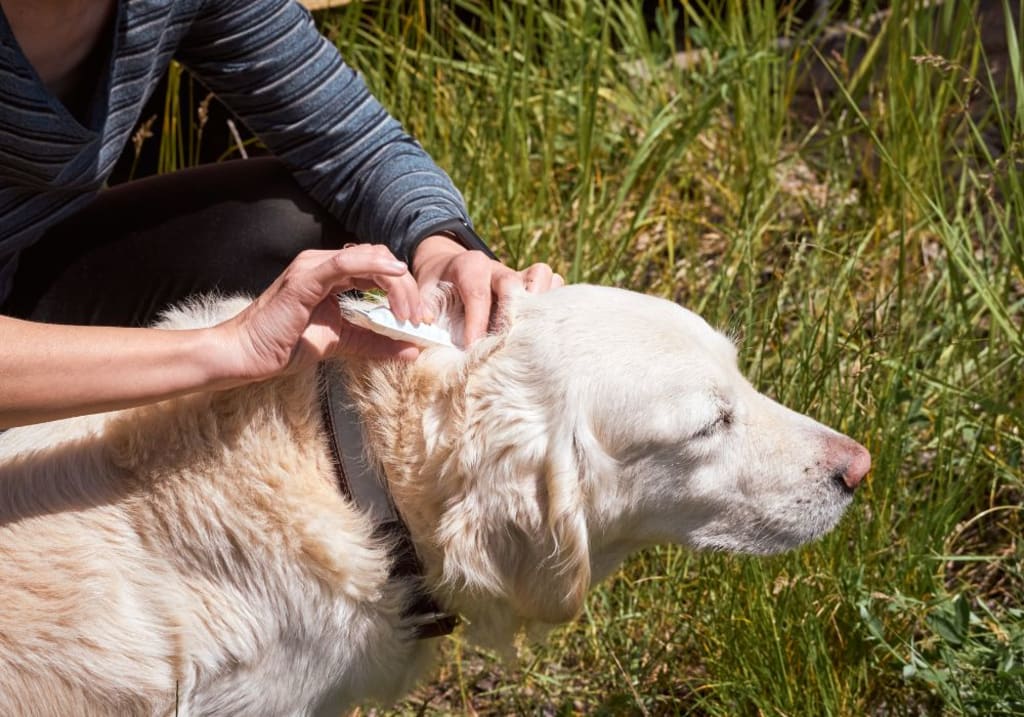Don't Let Fleas and Ticks Ruin Your Small Dog's Life
Find the Best Prevention Method Now!

Introduction: Overview of Flea and Tick Infestations in Small Dogs
Small dogs are prone to flea and tick infestations, as these parasites thrive in warm, moist climates. Fleas can cause skin allergies, anemia, or even tapeworm infection, while ticks can transmit diseases such as Lyme disease. Fortunately, there are a number of flea and tick prevention methods available to keep your small dog safe from infection. When it comes to the best flea and tick prevention for small dogs, there is no single "right" answer.
The best approach depends on the type of pet you have and its lifestyle. Some owners may prefer topical treatments such as spot-on drops or sprays; others may opt for chewable pills or collars. Whatever method you choose, it is important to treat your pet regularly to ensure maximum protection from parasites. In this article, we will explore some of the most effective flea and tick prevention methods available for small dogs. We will also discuss some important tips on how to pick the right product for your pup’s needs.
Identifying the Signs of Fleas and Ticks on Small Dogs
Small dogs are particularly vulnerable to fleas and ticks. Even if you take all the necessary precautions, fleas and ticks can still find their way to your pup. That’s why it is important to be able to recognize the signs of flea infestations or tick bites on your small dog. Knowing how to identify the symptoms of fleas and ticks can help you better understand what treatment methods are best for your pup.
Fleas
Fleas are small, flat parasites that feed off the blood of animals, including small dogs. The best flea prevention for small dogs involves checking them regularly for signs of fleas or flea eggs. Some common signs that may indicate a flea infestation include:
- An itchy sensation on your pup’s skin
- Excessive scratching
- Biting or chewing at fur
- Reddish brown specks in fur (flea dirt)
- Visibly seeing fleas running through fur
Flea infestations can cause serious health problems such as skin infections, anemia, and even death in severe cases. It is important to take immediate action if you notice any signs of a possible infestation. The best treatment option for small dogs is a topical medication that kills both adult fleas and larvae – this will help ensure that any existing infestations are eliminated quickly and effectively.
Ticks
Ticks are parasites that feed off the blood of animals, such as small dogs. They can spread serious illnesses like Lyme disease and Rocky Mountain spotted fever if left untreated. Some common signs that may indicate a tick bite on a small dog include:
- Itching around the bite site
- Redness around the bite site
- Swelling around the bite site
- Limping or refusal to move due to pain in affected area
Tick bites can be dangerous for small dogs so it is important to take immediate action if you notice any signs of a possible tick bite. The best prevention method for tick bites on small dogs is using a preventative tick product such as a collar or spot-on solution designed specifically for pets – this will provide long-lasting protection against ticks without putting your pet at risk from harsh chemicals or pesticides. This type of preventive measure will also allow you to monitor your pet more closely and catch any potential problems before they become more serious health issues.
Preventing a flea or tick problem before it starts is always the best way to keep your pup safe. By taking some proactive steps like using preventative products, checking regularly for symptoms of an infestation, and being aware of any potential risks from wild animals in areas where you walk with your dog, you can help make sure that neither fleas nor ticks ruin your pup's life!
Different Types of Flea and Tick Prevention for Small Dogs
It goes without saying that fleas and ticks can make your small dog's life a misery. Fleas don't just cause itching, they can also lead to skin infections while ticks can transmit diseases like Lyme disease. The best flea and tick prevention for small dogs is essential in order to protect them from these pests. There are several different types of flea and tick prevention available on the market today. Some of the most popular options include topical treatments, collars, oral medications, shampoos, sprays, and powders. Let's take a closer look at each one:
Topical Treatments
Topical treatments are probably the most common type of flea and tick prevention for small dogs. These treatments typically come in the form of an ointment or lotion that you apply directly to your dog's skin. They contain insecticides that will kill any fleas or ticks on your pet's skin immediately after application. However, these treatments must be applied regularly in order for them to be effective as they only last for a few weeks at a time.
Collars
Flea and tick collars are another popular option when it comes to preventing these pests from bothering your small dog. Collars usually contain an insecticide that is slowly released over a period of time so that it remains effective even when it gets wet or dirty. The downside is that some dogs may be sensitive to the chemicals contained in these collars so you should always check with your veterinarian before using one on your pet.
Oral Medications
Oral medications are also available for preventing fleas and ticks on small dogs. These medications typically contain an insect growth regulator which stops eggs from hatching, thus preventing any new infestations from occurring. The downside is that these medications must be given monthly in order to remain effective so you must remember to give them on a regular basis if you don't want your pet to get reinfested with fleas or ticks.
Shampoos
Shampoos are another option when it comes to preventing infestations of these pests on small dogs. These shampoos typically contain an insecticide which will kill any adult fleas or ticks on contact but will not prevent new infestations from occurring unless used regularly over a period of time. So if you're looking for something more permanent then this might not be the best option for you but if you're just trying to get rid of existing problems then this could work quite well.
Sprays & Powders
Flea and tick sprays and powders are also available which can help protect your pet from getting re-infested with these pests after they have been eliminated initially with another method such as topical treatment or shampooing etc.. These products usually contain an insecticide which will kill off any adult fleas or ticks as soon as they come into contact with them making them ideal for tackling existing problems but not necessarily preventing new ones from occurring in future unless used regularly over a period of time as well as other methods such as topical treatments or shampoos etc.
Finding the best solution is important when it comes to protecting your small dog from fleas and ticks so it is important to choose one that suits both their needs and lifestyle best! Talk with your veterinarian about the variety of options available so you can decide which type of flea and tick prevention is best suited for your four-legged friend!
Choosing the Best Flea and Tick Prevention for Your Small Dog
Fleas and ticks are pesky pests that can cause a lot of harm to your small dog. While fleas can cause intense itching, discomfort, and possible skin infections, ticks can potentially spread diseases like Lyme disease. That’s why it’s so important to make sure you use the best flea and tick prevention for your small dog. Fortunately, there are a variety of ways to help protect them from these bothersome bugs.
Topical Medications
One of the most popular methods for treating fleas and ticks in small dogs is through topical medications. These medications usually contain insecticides that when applied directly to the dog's skin will kill any pests present on their fur or around their ears. There are multiple brands available, but it’s important to make sure you read reviews to find out which one works best for your small dog. Additionally, keep in mind that topical medications need to be reapplied every few weeks depending on the product instructions.
Oral Medications
Another option you have is oral medications that contain insecticides as well as other ingredients like vitamins and minerals. These types of products come in either pill or chewable form, so you just need to find one that your dog will willingly take with ease. The benefit of using an oral medication is that results usually last a full month after taking one dose!
Spot-On Treatments
Additionally, spot-on treatments are another great way to prevent fleas and ticks from bothering your pup. They typically come in liquid form and are applied directly onto specific spots on the dog's body with an applicator or pipette provided with the product itself. Spot-on treatments have been proven effective against various types of insects including fleas and ticks! Plus they don't require any additional treatments throughout the month since they protect against infestations even after bathing or swimming!
Preventive Shampoos
If you'd rather use a more natural method instead, preventive shampoos may be just what you're looking for. They contain natural ingredients like rosemary oil extract or eucalyptus oil which repel insects without using harsh chemicals found in some products meant for killing them outright. Additionally, these types of shampoos also work great as regular hygiene products since they still cleanse away dirt while keeping pesky bugs at bay!
The best flea and tick prevention depends on many factors such as lifestyle preferences, budget constraints, whether any existing medical conditions exist etc., however all options mentioned above can provide excellent protection against these pesky parasites! Taking into account all the factors listed above when choosing between different methods should help ensure your pup stays healthy all year round!
Conclusion: Taking Action to Protect Your Small Dog From Fleas and Ticks
Finding the right flea and tick prevention method for your small dog can be an overwhelming task. With so many options available, it’s important to do your research and consider all of the factors that go into a successful flea and tick prevention program. The best flea and tick prevention for small dogs will take into account both external and internal methods of protection, as well as lifestyle considerations that will allow your pup to stay healthy and safe from fleas and ticks.
This includes finding products that are designed specifically for small breeds, using preventative medications, avoiding areas with lots of bugs, keeping grass short, grooming regularly, using natural deterrents like essential oils, and consistently washing pet bedding. By taking these preventative measures you can ensure that your pup is protected from the dangers of pests.
About the Creator
Hasan
Welcome...
In this site of mine you can learn amazing things and many information that you don't know so please subscribe to my site.
Enjoyed the story? Support the Creator.
Subscribe for free to receive all their stories in your feed. You could also pledge your support or give them a one-off tip, letting them know you appreciate their work.






Comments
There are no comments for this story
Be the first to respond and start the conversation.